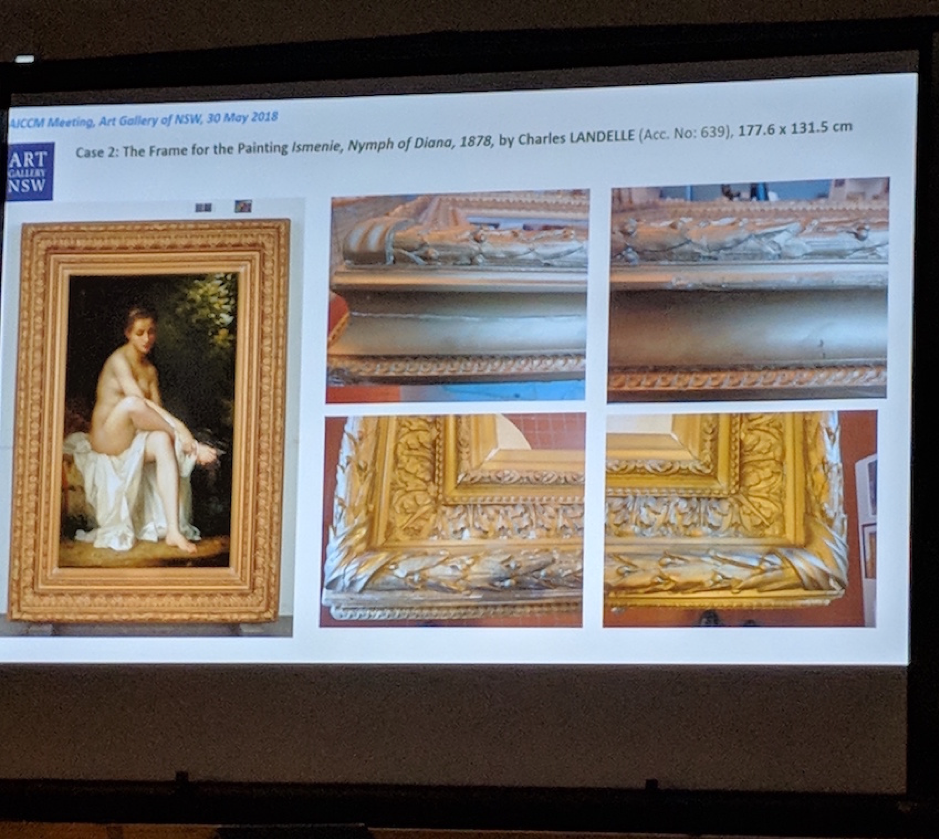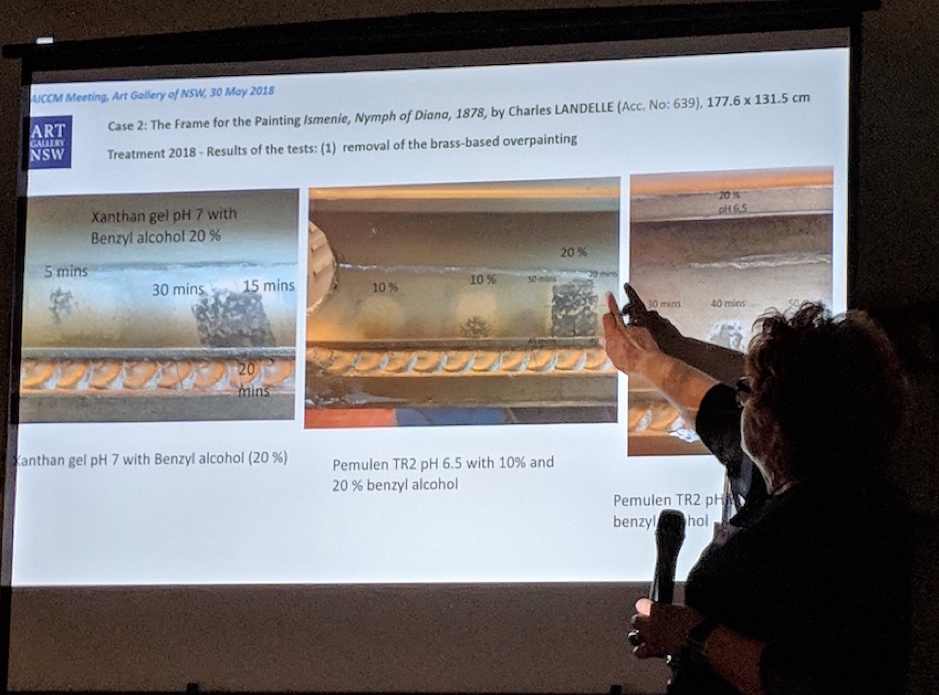In May, the Art Gallery of NSW hosted a casual evening of talks in their conservation labs for AICCM NSW Division members to discuss the use of ‘Gels in Conservation’. The evening was a great opportunity for those who attended the workshop ‘New Methods of Cleaning Painted Surfaces and Paper’, presented by Richard Wolbers in Melbourne earlier this year, to share their experiences of the workshop and subsequent testing of new materials and techniques back in our labs.

Rarely does a new tool or technique arise in conservation circles that can be applied across disciplines to so many and varied material types. Gels have been around in the world of conservation since the late 1980s, however many new gel materials have been introduced in the last decade that are now entering the lab. Gels represent additional tools that can be formulated and tuned to offer a wide range of physical properties, extending the range of materials available to the conservator in dealing with difficult cleaning problems. It was refreshing to come together as a broader conservation community to discuss the potentials of gels for our varied practices.

The evening began with a summary of Wolbers’ workshop by objects conservator, Kasi Albert. Kasi recounted that the workshop was heavy on the chemistry and Richard Wolbers dived right in! He began with getting everyone to think critically about approaches to cleaning, taking into account the chemical make-up of materials, solubility constituents and conductivity in making treatment decisions. There was an emphasis on replacing solvent use with aqueous preparations where possible, and playing with the chemistry of water to maximize cleaning potential through adjusting ionic strength and conductivity. There was also a focus on sustainability and using ‘greener’ cleaning agents, with less emphasis on surfactants and solvents. He introduced water-based gels such as Xanthan, silicon-based gels such as Velvosil and KSG 350z, and the use of silicon solvents such as cyclomethicone D2, D4 and D5 to act as a barrier before cleaning.
Paintings conservator, Sandi Mitchell, presented a number of case studies on applying these new materials and techniques in the paintings lab. She reiterated the advantages of gels in increasing the contact time of cleaning agents, and the ability to limit the amount of solvent that is held in solution. They are less toxic for the conservator, as there is less free solvent, and the gels presented are biodegradable, making them better for the environment. In theory, the gel is also restricted to the surface, not penetrating ground and size layers of a painting as free solvent does. Wolbers encouraged moving away from micro-emulsions to macro-emulsions, due to their easier clearance, less ingredients, and no surfactants. He also recommended substitution of traditional solvents with water-based systems to remove both dirt layers, overpaint and varnishes. Wolbers introduced Xanthan, a water-based polymer emulsion gel, that is non-toxic, biodegradable, and stable at any pH. It holds up to 20% solvent, and Sandi tested this with a 2% benzyl alcohol and pH6 water solution to remove dirt and oxidised natural resin varnish layers from an oil painting in one application, with great success. Being a water-based gel, it is not recommended for acrylics or other water sensitive surfaces. Water sensitive materials can be cleaned with the help of silicone solvents and gels such as KSG 350z. Sandi tested this successfully on a crosslinked varnish, identified as oil/copal, on a highly sensitive late 1940s Arthur Boyd.

Frames conservator, Margaret Sawicki, had recently returned from the Experts Meeting on the Cleaning of Gilded Wooden Surfaces at the Getty Conservation Institute in LA, which drew upon the resources of several GCI projects to discuss a range of valid cleaning systems, including gels. Paintings conservator and conservation scientist, Chris Stavroudis, presented at the meeting various cleaning systems based on gels and emulsions, and it was interesting to compare with the techniques presented by Richard Wolbers. Margaret explained the complexity of gilded surfaces and the history of using gels for cleaning, since Wolbers’ first workshop in Australia in the early 1990s. The earlier experiments with Carbopol gels and resin soaps were tested extensively for frames, but were largely abandoned with a preference for simply solvents and solvent poultices, as gels were less controllable and easily damaged the sensitive underlying gilding. Of particular interest from the recent workshops were the rigid gels, such as Agarose and Gellan, which can be left for a certain time and removed easily with no residue.


Frames conservators, Emma Rouse and Sofia Lo Bianco, presented two case studies of frames that had been included the recent Victorian Watercolours exhibition at the Art Gallery of NSW. To remove bronze overpaint, Emma tested Xanthan gel, which she found had a paste-like texture, was difficult to control and difficult to remove without damaging the gilded surface. She also tested the polyvinyl alcohol Borax gel with 50% acetone, which could be peeled off the surface to terminate the treatment and left no residue. For the dirt layers, she tested a number of rigid gels, such as Agarose gel with triammonium citrate, and Gellan, however being a rigid gel, it was difficult to acheive good contact on a complex frame surface. Sophia found the Gellan was most effective in removing a paper label from a frame. She also tested Pemulen TR-2 1% with various concentrations of EDTA and various application times. She found it had the appropriate viscosity for curved surfaces and ornament, as it conforms and restricts penetration into cracks. It was tested over a cyclomethicone film to protect the underlying gilding.
Paper conservators Analiese Treacy, Dominique Moussou and Sarah Bunn attended the Wolbers Works on Paper workshop, and re-iterated the intensity of the week-long workshop with a chemistry overload! They re-visited buffers, pH, solubility parameters and surfactants. Analiese highly recommended the Post-prints from the 2017 Tate conference ‘Gels in the Conservation of Art’, with many useful papers and formulations that have proven helpful for cross-discipline testing in the lab. So why use gels in paper conservation? They are good options to replace immersion treatments, where solubility and water sensitivity may be an issue, and they have many advantages similar to poultices. Analiese presented a successful treatment of a water stained Brett Whiteley mixed media artwork with paper collage elements. The paper was glued down to a poor-quality acidic wood support making traditional cleaning techniques difficult. Agarose gel, with nothing added, was found to be successful at significantly reducing the tideline staining that was thought to be impossible to remove by other means. Dominique presented the results of testing with Gellan gum washes, gaining good results with Japanese tissue barriers to reduce residues. She also continued tests with the Horiba liquid meter measurement to test the conductivity of pH of an object, tailoring wash water to meet the needs of the object. Sarah also had success with using Agarose, formed into discs in macaroon moulds, to reduce overall discolouration and foxing spots.
In all, the Wolbers workshops provided a good starting point for further testing and discussion. Wolbers appeared to be a bit of a “showman”, but encouraged the participants to take what they found most interesting and to “have a bit of a play”. While none of the speakers felt like they were experts on the topic, they have brought valuable information back to the labs and have provided the basis for some fruitful testing. Gels can clearly provide a direction for treatment but are not a ready-made solution. Most felt that more research and testing is required, with the need to be flexible when using gels and the need to use in a controlled way. They can be considered one of many options for our cleaning tool kit.
The evening rounded up with snacks and drinks, with further informal discussions. There were complimentary tickets to ‘The Lady and The Unicorn’ exhibition which many took advantage of! Many thanks to the organisers and to the Art Gallery of NSW conservation lab for hosting.